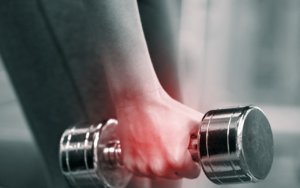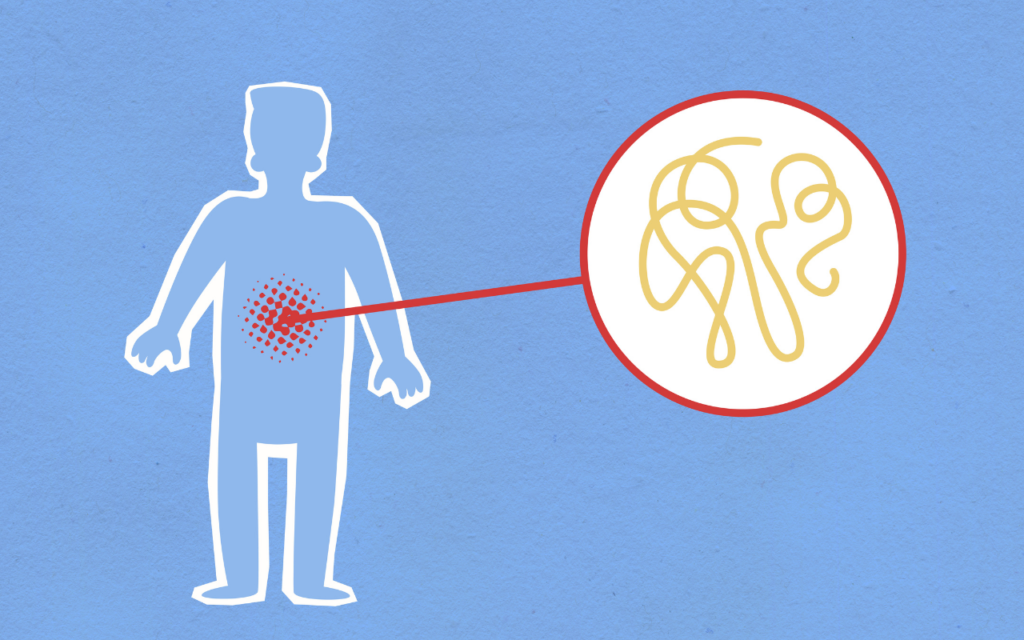Exercise and Inflammation
When the body's immune response gets stuck on overdrive, too much exercise can exacerbate the inflammation cascade.

Exercise and inflammation have an interesting relationship. As fitness professionals, we know that exercise can help boost the body’s immune system. But did you know that physical activity can actually produce an inflammatory response, leading to chronic inflammation? And when a body becomes chronically inflamed, a host of negative and potentially injurious conditions can result.
Like other stressors in our lives—allergic reactions, lack of sleep, emotional duress, poor nutritional intake and excess body fat—exercise can directly affect the body’s complex immune system and produce a cascading effect of inflammatory responses.
The purpose of this article is to briefly explain the body’s immune system and the inflammatory process, describe the cumulative effect of inflammation on different body systems and provide strategies for modifying exercise programs to reduce inflammation levels.
Inside the Inflammatory Process
What is the interplay between exercise and inflammation? Let’s first look at the body’s inflammatory process is a wonderful part of the immune system, designed to protect us from invading microbes, chemicals and allergens; physical trauma; and other threats both real and imagined. Inflammation occurs at the peak of the immune response when conditions such as fever trigger the body to increase blood flow and bring in specialized immune cells to help repair and remove damaged tissues. The inflammatory response has been well understood for centuries, beginning with Hippocrates, who may have been the first to regard inflammation as the beginning of the healing process (Ley 2001).
An acute (short-term) response to internal and external invaders is the basis of a successful immune system. However, when inflammatory stressors become chronic (long-term) and accumulate, trouble begins. These stressors affect a delicately balanced biochemistry designed to protect our bodies from potential damage; that balance is called homeostasis.
The immune system is divided into two types of responses: natural and specific. The natural response is an all-purpose first line of defense comprising cells that identify and attack a number of different invaders in a short time frame. Neutrophils and other cells devour invading pathogens and initiate inflammation by releasing toxic substances that damage and then consume the invader or damaged tissue (Segerstrom & Miller 2004). Neutrophils release communication molecules known as cytokines, which play an important role in immune responses to internal and external threats to homeostasis (Segerstrom & Miller 2004).
The second component of the immune system, the specific response, is far more complex and mostly beyond the scope of this discussion. Simply put, the specific response recognizes a specific invader, like bacteria or an allergen, and then mounts a defense against it. The specific response relies on the natural response to fend off invaders or damaged cells while establishing a defense that can quickly respond the next time homeostasis is disrupted (Segerstrom & Miller 2004).
This intricate protective mechanism helps maintain the biochemical balance in the body that maintains health or promotes healing. Many body systems must remain balanced for homeostasis to occur. One important example is the endocrine system, which controls much of the body’s regulating hormones, the body’s pH, body temperature and chemicals in the bloodstream, all of which are delicately balanced and vulnerable if altered for a significant length of time (Appleton 2004).
See also: Hormone Health and Functional Aging.
Physical & Mental Stressors
It should be noted that the immune system is well designed to handle such physical stressors as microbes, sprained ankles and hay fever. What is not clear, however, is how the immune system reacts to the accumulation of other physical stressors—poor nutrition, lack of sleep, food allergies or sensitivities, postural and joint misalignment and foreign substances.
Additionally, behavioral scientists have been examining the effect of mental and emotional stressors on physiological health for upwards of 80 years (Linden 2004). Significant research has indicated that mental stressors provide as great a challenge to homeostasis as physical conditions like influenza or muscle tears (Linden 2004).
The term allostatic load refers to the method by which the body adjusts to the combined effect of many physical and mental stressors. A high allostatic load is essentially an overload of those different stressors, creating what one researcher dubbed “a cascade of cause and effect” (McEwen & Seeman 1999).
The connecting factor among physical, emotional and mental stressors occurs in an area of the brain known as the HPA axis. Consisting of the hypothalamus, pituitary gland and adrenal gland, the HPA axis serves as the body’s emergency alert system that responds to a variety of stressors by releasing hormones, such as epinephrine and norepinephrine, which prepare different body systems for action. The HPA axis also releases growth hormone (GH) and cortisol; GH helps repair tissue and promotes growth, whereas cortisol fuels the body by maintaining proper glucose and fatty acid levels (Meggs 2004; Lovallo 2004).
When faced with a lot of different stressors (i.e., a high allostatic load), the intricately tuned immune system can get caught in a stress hormone–inflammation loop. Hormones are released at higher than normal levels, leading to an increase in proinflammatory cytokines, which, in a vicious circle, then restimulates the HPA axis. Cortisol levels also increase and alter the immune/
inflammation system, resulting in higher levels of inflammatory factors in the body (Meggs 2004; Talbott 2002; Sears 2005).

Too much exercise can exacerbate inflammation.
Exercise and Inflammation
So how do the immune system, HPA axis and stress response all fit into the exercise and fitness equation? Exercise is a physical stressor, and the exercise stress response follows similar inflammatory physiological pathways to those activated by other physical and mental stimuli.
In fact, the response to exercise is so parallel that exercise scientists borrowed the phrase general adaptation syndrome (GAS) from Hans Selye, a behavioral scientist who pioneered much of the early extensive research on the stress response. According to Selye, stress causes a temporary decrease in function, followed by an adaptation that improves function. In order for us to improve our health, fitness or athletic ability, it is necessary to increase our efforts to fatigue-level intensities and then recover and refuel (Kreider, Fry & O’Toole 1998).
During exercise, the primary hormones that get released are
- epinephrine (to increase heart rate and blood flow to the muscles)
- norepinephrine (to raise blood pressure)
- cortisol (to mobilize fuel sources and lower any inflammation)
- growth hormone and glucagons (to protect blood glucose and mobilize other energy sources for fuel)
These hormones are the same as those secreted when the body is reacting to mental and emotional stressors.
If the exercise session was designed to elicit higher levels of strength or conditioning, some degree of muscle damage occurred, calling upon the immune system to respond in a number of ways, including an inflammatory response to help muscle repair. While this process promotes muscle regeneration, it can also slow the body’s ability to repair muscle tissue (Tiidus 2008).
See also: Human Growth Hormone Use Among Men.
Contributing Factors
Many factors play a significant role in increasing body inflammation, including physical imbalances, diet, allergies, sleep deprivation, excess weight and age.
Physical Conditions. Postural and joint malalignments play a major role in inflammatory conditions. Exercisers who spend long periods of time sitting each day are especially vulnerable when performing certain upright movements that can create
excessive friction in joint complexes. Excessive shoulder internal rotation, thoracic flexion and hip external rotation are classic seated malalignment issues that result in pain or damage to
areas that then become inflamed (Sahrmann 2001).
Poor Diet. One huge contributing factor to inflammation is the Western convenience/comfort food diet, which is high in saturated and trans fats, simple carbohydrates and animal proteins (Sears 2005; Appleton 2004; Meggs 2004). The American Dietetic Association (ADA) urges Americans to reduce their consumption of saturated and trans fatty acids to diminish risk factors for inflammation-based disorders such as cancer, cardiovascular disease, cerebral infarction and other immune disorders (ADA 2007). Food allergies and sensitivities also contribute to inflammation. The most common food allergies involve wheat gluten, nuts or shellfish. While less severe than allergies, food sensitivities can produce subtle inflammatory reactions to common trigger foods; for example, products made with dairy, corn, soy, wheat, sugar and nuts (Meggs 2004). For a look at additional nutrition recommendations, see the sidebar “Diet & Inflammation.”
Other Allergens. In addition to food, allergens such as chemicals, dust, mold or pollens can cause the body’s immune system to release chemical neurotransmitters called histamines, which trigger an inflammatory process in the blood vessels. The allergic reaction can be slight (e.g., itchy skin, runny nose) or far more serious (e.g., blood pressure drop, swelling, shortness of breath). Environmental pollutants, cleaning products and noise can also increase inflammation (Meggs 2004; Appleton 2004).
Sleep Deprivation. Lack of sleep is associated with inflammation. Sleep is a time for the body to recover and repair both mentally and physically. That’s why sleep experts recommend getting 7–9 hours nightly to function optimally. Studies indicate that this time period is critical for biochemical balance in substances like GH and cortisol (Dement 2000).
Excess Weight. Biochemical imbalances have also been linked to inflammation caused by excess intra-abdominal fat. Beyond a certain level, excessive intra-abdominal fat produces a cortisol response, which tells the body to store fat; this begins a never-ending feedback loop (Talbott 2002; Meggs 2004).
Advanced Age. Another contributing factor is age. As we age, interleukin levels increase dramatically, which plays a role in the development of many diseases of aging, including heart disease, osteoporosis, Alzheimer’s disease and other cognitive impairment diseases (Meggs 2004).

Researchers have found links between inflammatory conditions.
The Link Between Inflammation & Disease
Over the past 5–10 years, advances in measuring immune system responses have allowed scientists to measure specific hormones and chemical agents that contribute to the cascade effect of inflammation. Researchers have found links between different inflammatory conditions, such as the relationship of gum disease to atherosclerosis, depression to allergic reactions and chronic fatigue syndrome to the common cold (Meggs 2004; Enwonwu & Ritchie 2007).
Unfortunately, current research is inconclusive as to the specific causes and effects in the interrelationship of inflammatory elements. Behavioral scientists have linked stress loads to asthma, skin and gastric disorders, and sexual dysfunction (Meggs 2004; Linden 2004). Neuroscientists have shown that specialized nerves close to the skin, airways, urogenital tract and gastrointestinal tract play a significant role in the inflammatory process in those areas (Meggs 2004; Butler 2006). Animal studies have found a link between repetitive-use injury in an isolated limb and tissue damage and inflammation in nonrelated limbs (Barr, Barbe & Clark 2004; Tiidus 2008).
Tailoring Exercise Programs
These tangential links may make you want to throw in the towel when faced with clients who have inflammatory conditions. After all, if there is a negative connection between exercise and inflammation, shouldn’t you reconsider programming? The good news is that armed with enough information and resources, fitness professionals can be effective in attenuating the inflammatory cascade. The key is to sometimes work against your instinct and years of training to design workouts that accommodate these exercisers’ needs.
When working with clients who want to lose weight or gain muscle mass, it can be tempting to offer high-intensity workouts, but too much intensity can result in an inflammation/stress response and a limited recovery process. In a matter of a few workouts, the client’s body could be thrown into a chronic state of inflammation resembling overtraining. That’s why proper exercise recommendations for this client would need to take into account pre-existing inflammatory conditions.
Research indicates that high-intensity (> 70% of maximal effort) exercise sessions lasting longer than 20–30 minutes or low-intensity (< 50%–70%) efforts lasting longer than 75 minutes can flood the body with stress and inflammation biochemical markers, initiating a cascading response (Borer 2003; Tiidus 2008). It therefore makes sense to devise a workout that stays within those time and intensity parameters. It’s equally important to educate clients about these limitations. Teach clients to measure their individual peak efforts using methods such as the maximal heart rate during a 30- to 60-minute effort or rate of perceived exertion (RPE) (Smith 2004).
Moderate exercise at lower intensities is the better course. Moderate exercise efforts for up to 60 minutes can actually reduce inflammatory markers, increase positive neurotransmitters (e.g., serotonin and endorphins) and improve brain chemistry (Ratey 2008). Moderate intensities also stimulate the growth of new brain cells, neurons and capillary growth to muscles and neurons. (Ratey 2008).
According to most studies, exercising under the 70% effort level seems to be the baseline for reducing inflammation and stress hormone levels. Fitness professionals and exercisers should note that this effort is substantial (the Borg RPE scale would place it near the “somewhat hard” category). Keep in mind that at this effort, a 10-repetition maximum at 100 pounds (lbs) would be 10 reps at 70 lbs, to avoid making exercise the breaking point of the allostatic load.
These reduced efforts should be combined with exercise programming design that includes myofascial release, flexibility training and corrective exercise. This type of program can help relieve stress, improve joint alignment and muscle activation and reduce the inflammatory response.
Fitness professionals can also help exercisers understand the need to develop better lifestyle behaviors that affect their physiology. Asking simple questions about lifestyle patterns can perhaps open the client’s eyes to the cumulative effect of physical and mental stressors.
See also: Moderate-Intensity Exercise Boosts Calorie Burning for an Entire Day.
Exercise and Inflammation: The Mental Element
Another key element when dealing with chronic inflammation is creating a positive mental environment around the client’s workout. Fitness professionals need to emphasize that it is perfectly acceptable to give less of an effort and work at lower intensities during times of high stress. Sometimes the best workout is restorative in nature or personalized to maintain current fitness levels. Teach clients that high-intensity, long-duration workouts are counterproductive if performed during a time of high demands and increased stress in other areas of life.
Although goals are important in increasing health and fitness levels, those goals need to incorporate and work with clients’ needs outside of the gym. Additionally, while peer support is essential, too much pressure during exercise sessions can create and add a whole new set of stressors to the mix (Linden 2004; Lovallo 2004).
If you sense that clients are unwilling to decrease the intensity of a workout, you need to remind them that managing the hormonal component of exercise can actually help produce gains. Explain why the outdated “no pain, no gain” approach can actually be detrimental to their health because at best it stimulates the body to retain body fat or lose muscle mass and at worst it creates a chronic state of injury and illness.
Research on the topic of exercise and inflammation also supports the healing power of 7–8 hours of sleep. Sleep is critical to maintaining biochemical homeostasis. The primary function of sleep is to give the body and the mind some restorative time to help decrease systematic inflammation (Dement 2000).
It would be hard to underestimate the importance of a positive outlook when dealing with chronic inflammation. Staying upbeat can help exercisers improve their physiology at the very basic level to enable further health improvements. A stunning example of positive outlook producing positive results came from a study of patients with osteoarthritis needing standard knee surgery; even though the control group participants did not undergo any type of surgical procedure, they still showed improvements similar to those who did have surgery, which was attributed to their belief in a positive outcome (Lipton 2005). One member of the control group who previously had to walk with a cane was playing basketball with his grandchildren 2 years later (Lipton 2005). While there are many anecdotal reports of individuals who make stunning recoveries from serious illness through the power of prayer, positive thinking, visualization, meditation and other mental and emotional therapy, this study helps quantify the power of the mind in an area not usually addressed: pain from tissue damage. That’s why it is vital to stress the importance of outlook over outcome, and encourage clients to hold on to their positive beliefs.
Exercise and Inflammation: There are Solutions
As we understand more about exercise and inflammation and disease, the role of the modern fitness professional will become more important as the first line of defense in the health care continuum. Understanding how various internal and external stressors affect the inflammatory process will enable us to provide sound exercise recommendations and tailor programs to enhance the lives of people who deal with chronic inflammation.
See also: Fit Pros and the Healtcare Continuum.
Updated on September 8, 2021
Diet & Inflammation
Research on the topic of chronic inflammation underscores the importance of proper fuel timing to support workouts. One study found that ingesting electrolyte/carbohydrate solutions during the workout reduced the cortisol response 10-fold compared with drinking water alone. Additionally, consumption of a carbohydrate and protein meal at a 4:1 ratio within an hour, then again 3 hours postworkout, appears to improve the anabolic hormonal response significantly. The same researchers found that glutamine supplementation can almost double the muscle repair process and that other antioxidants, such as vitamin C and betacarotine, have proven effective in speeding muscle recovery and minimizing the stress response (Ivy & Portman).
Along with workout nutrition strategies, clients can implement several proactive anti-inflammatory nutrition strategies that are fairly simple. For example, research has shown that inflammation can be prevented or reduced by the following:
- adding more fruits and vegetables to the diet
- reducing intake of trans fats and saturated fats
- increasing intake of omega-3 fats (found in fish oils, olive oil, avocados and walnuts)
- reducing intake of simple carbs and animal protein (Meggs 2004; Appleton 2004; Sears 2005)
Some herbs and other phytochemicals have been shown to significantly reduce inflammation in the body. For example, an active component in the herb turmeric called curcumin has been studied extensively for its ability to inhibit cancer cell growth. Ginger has exhibited the same properties. Some dietary supplements combine tumeric, ginger, rosemary, basil and other herbs to create a potent natural anti-inflammatory with no known side effects. Studies have found that this specific combination is as effective as some pharmaceutical compounds at stemming inflammation (Katz et al. 2005).
A Note on NSAIDS
No discussion on the subject of inflammation would be complete without looking at one of the most widely used (perhaps over used) treatments: nonsteroidal anti-inflammatory drugs. Commonly called NSAIDs, these agents have an analgesic (pain-relieving) effect and when used over a period of time help reduce inflammation.
NSAIDs work to inhibit hormones in the body called prostaglandins, which are vital to many physiological processes but specifically cause the sensation of pain as a protective mechanism. Because these hormones are important in gastric function and because NSAIDs eliminate all prostaglandin activity, gastric distress can be a side effect (Medinfo 2008). Newer studies are finding that instead of speeding recovery from muscular injury, ingestion of traditional NSAIDs may actually slow the process for several days as protein synthesis (tissue healing) is delayed (Medinfo 2008). NSAIDs are currently being developed that may be more selective in nature and have fewer side effects.
Common types of traditional NSAIDs include aspirin, ibuprofen, naproxen, ketoprofen and indomethacin. It should be noted that while acetaminophen (Tylenol) is classified as an NSAID, it exhibits little or no anti-inflammatory effects despite its analgesic properties.
Despite the recent advances in pharmacology, many medical professionals prefer to use the more time-honored approaches of allowing the body to heal itself, while staying flexible and active.
References
American Dietetic Association (ADA). 2007. Position of the American Dietetic Association and Dietitians of Canada: Dietary fatty acids. Journal of the American Dietetic Association, 107 (24), 1599–1611.
Appleton, N. 2004. Stopping Inflammation. Garden City Park, NY: Square One.
Barr, A.E., Barbe, M.F., & Clark, B.D. 2004. Systemic inflammatory mediators contribute to widespread effects in work-related musculoskeletal disorders. Exercise and Sport Sciences Reviews, 32 (4), 135–42.
Borer, K.T. 2003. Exercise Endocrinology. Champaign, IL: Human Kinetics.
Butler, D.S. 2006. The Sensitive Nervous System. Adelaide, Australia: NOI Group.
Dement, W.C. 2000. The Promise of Sleep. New York: Dell.
Enwonwu, C.O., & Ritchie, C.S. 2007. Nutrition and inflammatory markers. Journal of the American Dental Association, 138 (1), 70–73.
Ivy, J., & Portman, R. 2004. Nutrient Timing. North Bergen, NJ: Basic Health.
Katz, A.E., et al. 2005. Zyflamend, a unique herbal preparation with nonselective OCX inhibitory activity, induces apoptosis of prostate cancer cells that lack COX-2 expression. Nutrition and Cancer, 52 (2), 202–212.
Kreider, R. B., Fry, A.C., & O’Toole, M.L. 1998. Overtraining in Sport. Champaign, IL: Human Kinetics.
Ley, K. 2001. Physiology of Inflammation. New York: Oxford University Press.
Linden, W. 2004. Stress Management: From Basic Science to Better Practice. Thousand Oaks, CA: Sage.
Lipton, B. 2005. The Biology of Belief. Santa Rosa, CA: Mountain of Love.
Lovallo, W.R. 2004. Stress and Health. Thousand Oaks, CA: Sage.
McEwen, B.S., & Seeman, T. 1999. Protective and damaging effects of mediators of stress: Elaborating and testing the concepts of allostasis and allostatic load. Annals of the New York Academy of Sciences, 896, 30–47.
Medinfo. 2008. Non steroidal anti-inflammatory drugs. www.medinfo.co.uk/drugs/
nsaids.html; retrieved June 1, 2008.
Meggs, W.J. 2004. The Inflammation Cure. New York: McGraw-Hill.
Ratey, J.J. 2008. Spark: The Revolutionary New Science of Exercise and the Brain. New York: Little, Brown.
Sahrmann, S.A. 2001. Diagnosis and Treatment of Movement Impairment Syndromes. St. Louis: Mosby.
Sears, B. 2005. The Anti-Inflammation Zone. New York: Collins Living.
Segerstrom, S.C., & Miller, G.E. 2004. Psychological stress and the human immune system: A meta-analytic study of 30 years of inquiry. Psychological Bulletin, 130 (4), 601–30.
Smith, L.L. 2004. Tissue trauma: The underlying cause of overtraining syndrome? Journal of Strength and Conditioning Research, 18 (1), 185–93.
Talbott, S. 2002. The Cortisol Connection. Alameda, CA: Hunter House.
Tiidus, P.M. 2008. Skeletal Muscle Damage and Repair. Champaign, IL: Human Kinetics.
Charlie Hoolihan
Director of personal training for the Pelican Athletic Club in Mandeville, Louisiana. He is a member of the IDEA personal trainer membership committee, a fitness writer and presenter. Certifications: NASM, NSCA






